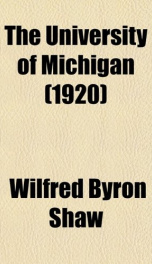the university of michigan

Purchase of this book includes free trial access to www.million-books.com where you can read more than a million books for free. This is an OCR edition with typos. Excerpt from book: CHAPTER III THE UNIVERSITY'S EARLY DAYS There were several candidates among the towns of the State for the honor of having the University. Detroit, Monroe, and Marshall were mentioned, but an offer of forty acres of land by the Ann Arbor Land Company, previously offered unsuccessfully as a site for the state capitol, proved the most attractive bid, and the Legislature voted in favor of Ann Arbor in an act signed by the Governor, March 20, 1837. The town was then fourteen years old and boasted some 2,000 inhabitants, who supported four churches, two newspapers, two banks, seventeen drygoods stores, eleven lawyers, nine doctors, and eight mills and manufacturing plants, including a good-sized plow factory. Nevertheless it was in essentials a frontier community. There are those still living who remember the Indians who came in to town to trade,presumably at those seventeen drygoods stores. Transportation was primitive, the first railroad did not come until 1839; while great tracts of uninhabited land lay on every side. Of the twelve Regents by appointment who were members of the first Board, six had been members of the Constitutional Convention, two were physicians, and four were lawyers; seven had received collegiate degrees, while one, Henry R. Schoolcraft, was the best authority of that time on the American Indian. General Crary appears to have been the only one who had previously concerned himself witheducational matters, so it is small wonder that some impracticable measures were taken. To those of us who look back now with the advantage of "hind-sight," the mistakes of the first Board are obvious. Two tracts of land were considered as possible sites for the University. The choice fell upon the wrong one, and we now have the present Campus, undistinguished by any natu...
Info about the book
Author:
Series:
Unknown
ASIN:
B009MQ18JK
Rating:
4/5 (1)Your rating:
0/5
Languge:
English
Users who have this book
Users who want this book
What readers are saying
What do you think? Write your own comment on this book!
write a commentGenre
if you like the university of michigan try:
Other books by this author
Do you want to exchange books? It’s EASY!
Get registered and find other users who want to give their favourite books to good hands!

